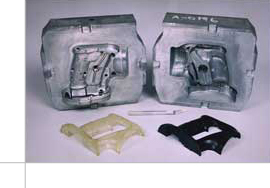
 |
Cast Kirksite Cavities Re-emerge as Rapid Tooling Approach

Armstrong Rapid Manufacturing is using a prototype injection molding process that employs cast kirksite cavities from SLA models to mold parts in "two-to-three weeks in just about any thermoplastic production resin," according to Paul Armstrong, director of sales and marketing at the company. The cast kirksite cavities are said to provide "excellent rapid tools for prototype and bridge-to-production injection molded parts."
Kirksite is a zinc-aluminum alloy with excellent wear resistance. Although the technology has existed for decades, the kirksite approach has recently re-emerged with the growth of SLA and the need for rapid turnaround of prototype plastic parts, Armstrong said. One advantage of the zinc-aluminum alloy molds is the ease of making simple geometric changes to a design by either welding or adding inserts, Armstrong noted. Another advantage is the ability to mold most materials with very fast turnaround. "This expedites the design refinement loop as well as providing fully functional parts for the testing and approval processes before ordering production tooling," Armstrong explained. "Ultimately, OEMs are able to bring better products to market faster."The kirksite mold cavities are created from an SLA master pattern via the plaster-mold casting process. The cavities are then mounted in standard D-M-E bases with standard injector and runner systems, or they can be run in a stand-alone manner. Heating and cooling lines can be cast in place or added later by drilling.
To keep mold costs down and speed up the turnaround time, the molds are kept as simple as possible, Armstrong says. Handloads are used instead of mechanical pullbacks and slides, and "four or five handloads are not uncommon." Unit costs are higher because molds are built for cost savings and fast turnaround, rather than total efficiency, he said.
Tool life is dependent on many factors, particularly the material used. Although prototype runs of 50-1000 pieces are typical, some molds reportedly have run up to 200,000 pieces, indicating that the technology can supply production quantities in low-volume applications.
Armstrong cautions that some tolerance loss can be expected because the master file must incorporate shrink factors for both the kirksite and the plastic. For critical local areas, geometry can be CNC-milled into the mold. The process will, however, provide "perfectly acceptable parts for functional use at a lower cost and much faster turnaround than a machined steel mold," Armstrong concludes.
|
|
| Home | About Us | Back To Technical Library | Contact Us |
|
Copyright © 1996-2010 JobShop.com. All Rights Reserved. General or Technical Questions? E-mail support@JobShop.com |